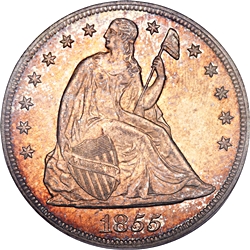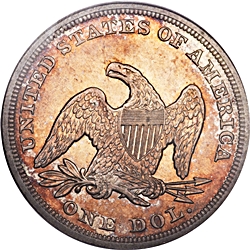 |
1855 
 |
 |
General CommentsMint state examples are very rare. Only 41 examples have received a mint state grade at any level from the two major grading services, and several those examples are surely re-submissions. Choice examples are truly rare, virtually unobtainable. In MS63 or better this is one of the toughest dates in the entire series. The finest known business strike is a single MS64+ example graded by PCGS. Each service has graded one additional coin MS64. PCGS has graded six additional coins MS63. NGC has graded only two at that level. Again, a few of these are probably duplicates. We must add, however, that we believe a few of the 1855 coins slabbed as proofs are actually early business strikes. This could explain the incredibly small number of high-grade business strikes. We note, however, that lower grades are a little more available than 1854 examples. PCGS has graded 14 coins in the VF grade range, and 7 lower. NGC has graded 4 VF, with only one lower. Population statistics are as of January, 2019. |
|
1855 proofs are rare, but not as rare as their counterparts in the 1840’s. We estimate the mintage at 60-75, with around 40 surviving today. Population reports show a total of 42 graded by the two major services. These almost certainly include a few re-submissions and at least one or two early business strikes incorrectly attributed as proofs. That said, there’s no conclusive way to differentiate proofs from business strikes, since they come from the same die pair. It’s a judgment call, based on strike and appearance. The highest proofs graded are PR66, with two at this level, one graded by each service. The NGC coin is designated as cameo. PCGS shows a single coin graded PR65+, with a cameo designation. NGC shows four at that level, with one cameo and one PR65+. PCGS has graded 13 coins PR64, including one plus and three cameos. NGC has graded 7 at the PR64 level. 1855 proofs are usually found with strong strikes. Any strike weakness could be an indication that the coin is an early business strike. Population statistics are as of January, 2019.
1855 Die Marriages
We’ve identified only a single die pair for 1855. Both proofs and business strikes were coined from the same die pair. The following table summarizes the known die marriages:
Die Marriage |
Rarity |
Obverse Die |
Reverse Die |
Estimated Survivors |
| OC-P1 | R5+ | P1 | PA | 40 |
| OC-1 | R3+ | P1 | PA | 300 |
As noted in the table above we’ve assigned separate identifiers to the proofs and business strikes, but it should be noted that differentiating between the two is a judgment call, based mostly on strike and appearance. Middle to late die states of the business strikes exhibit a reverse die crack that extends up from the rim through the lower left side of the E in ONE to the upper right side of the N. This die crack is unique to business strikes. Proofs exhibit a die line on the rim below the E in ONE, but it’s not unique to the proofs. We’ve seen this die line on a few early issue business strikes. These features are pictured in the descriptions of the individual die marriages.
One additional subject needs to be addressed before leaving the discussion of 1855 die marriages. Both Breen (reference 7 and reference 20) and Bowers (reference 4) concluded that 1855 business strikes used an obverse die that differed from the proof obverse. They also concluded that the prevailing 1855 proof die pair, which would be our OC-P1 die marriage, used a reverse die that was transitional from 1854. We are certain that both these observations are incorrect. The 1855 business strike and proof obverse dies are the same. We’ve identified three different reverse dies on 1854 proofs. None are transitional to 1855. Breen then identifies a second, much rarer, proof die pair, with the same obverse die paired to a different reverse. After years of searching we’ve been unable to confirm the existence of this second die pair. Bowers also included a second die pair in his reference (reference 4). We believe that his second proof die marriage was a re-iteration of Breen’s incorrect conclusion. We will, however, remain on the lookout for any future data that might confirm the existence of the second die pair.
1855 Emission Sequence
With only a single die marriage the emission sequence isn’t terribly interesting, but it should be noted that our observations of die wear indicate that the proofs were minted prior to the business strikes. This supports the conclusion that a few coins identified as proofs are actually early business strikes, since the dies had been polished for the proof strikings. The first business strikes issued were almost certainly highly prooflike.
Emission Order |
Die Marriage |
Comments |
| 1 | OC-P1 | Die wear indicates that the proofs were minted prior to the business strikes |
| 2 | OC-1 |
1855 Quick Finder Chart
With only a single die pair attribution is easy. The only difficulty is separating proofs from business strikes.
Die Marriage |
Obv. Die |
Rev. Die |
Right Base |
Keys to Identification |
| OC-P1 | P1 | PA | JL of C | Obverse: Date is just below centered, slanting down. Base of 1 is JL of C.
Reverse: A die line on the rim below the left side of the D in DOL (also seen on early die state business strikes). No die crack from the rim below the E in ONE. |
| OC-1 | P1 | PA | JL of C | Obverse: Date is just below centered, slanting down. Base of 1 is JL of C.
Reverse: A die line on the rim below the left side of the D in DOL only for early die states. A die crack from the rim below the E in ONE to the upper right side of the N in ONE only for middle to late die states. |
| Photo credits:
Obverse and reverse full photos: PCGS MS64, ex. Gene Gardner, from the Heritage archives. |
